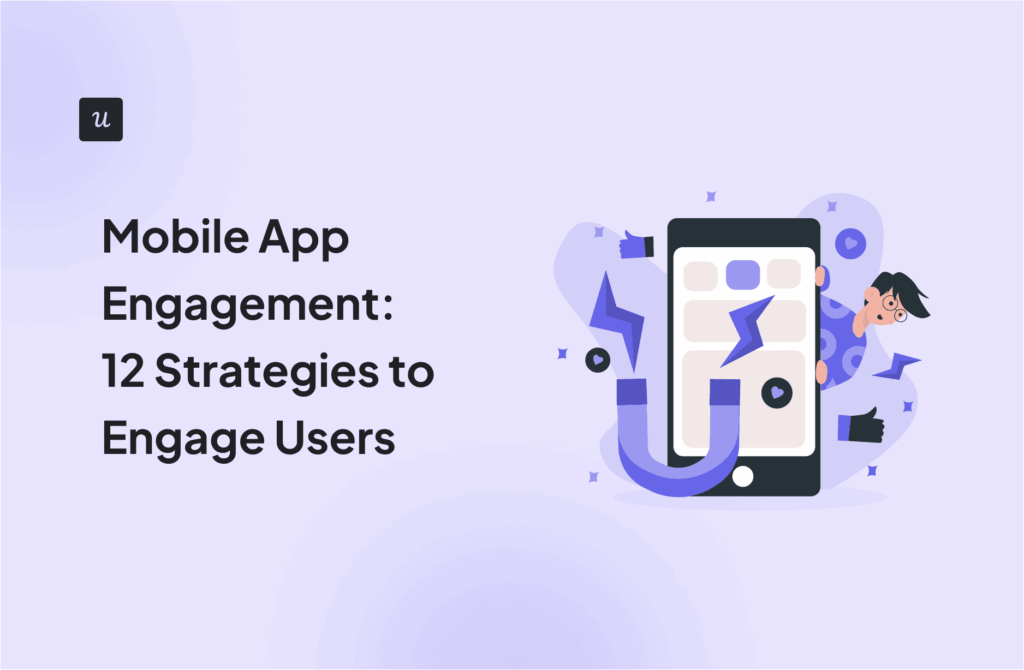![How to Increase Monthly Active Users in SaaS [+Examples Included] cover](https://blog-static.userpilot.com/blog/wp-content/uploads/2022/02/how-to-increase-monthly-active-users-in-saas-examples-included_45f7ab0d64e378d677c97538f60aaab6_2000.png)
Are you looking for ways how to increase monthly active users for your SaaS?
We’ve got you covered. In this article you’ll learn:
- What monthly active users (MAUs) are and why you should care.
- 8 ways to turn passive customers into engaged users.
- The best user engagement tools to use to turn new users into active users.
Try Userpilot Now
See Why 1,000+ Teams Choose Userpilot

What are monthly active users (MAU) in SaaS?
Monthly active users (MAUs) refer to the number of unique visitors that engage with your web or mobile app in a month (i.e. actively using your product).
MAU is a key performance indicator (KPI) that companies use to track user engagement. To make the metric more effective, only unique visits should be tracked.

Tracking monthly active users without coding in Userpilot
How to measure and track monthly active users (MAUs)
Measuring MAU is beyond just checking figures; if those numbers don’t tie directly to your business objectives, then they make no sense.
To start tracking monthly active users, you should determine what constitutes an active user for your product. For instance, in a SaaS context, an active user might interact with your core feature on a weekly basis.
Once this definition is clear, employ an analytics tool like Userpilot to collect user activity data via event tracking. From there, identify key metrics that correspond to your business goals, such as login frequency or feature usage.

With these metrics established, proceed to calculate monthly active users by tallying the total number of unique users engaging with the product within the designated month.
For more granular insights, you can even segment users based on attributes like demographics or behavior.
How to measure and track daily active users (DAUs)
Tracking daily active users is almost the same as calculating monthly active users. You also have to define what it means as a daily active user for your product.
From there, continue with determining all the relevant metrics that you should track i.e. daily logins, feature usage, etc.
You can have all these metrics tracked and calculated automatically using an analytics tool. For example, in Userpilot, once you know what event to track, you can monitor daily active users using various types of analytics dashboards (i.e. line graphs, bar charts, etc.)

How to increase product engagement and grow monthly active users
This section will show you proven ways to improve engagement, which naturally increases MAUs. You’ll find examples and actionable tips you can begin implementing right away.
Offer personalized experiences from the start
Start by using a welcome survey to gather information about your users’ feature preferences and the tasks they need to accomplish (jobs to be done).

By doing so, you can trigger onboarding flows tailored to their specific needs. This tailored approach ensures that you can introduce users to the most relevant features and functionalities based on their responses.
As a result, they are more likely to engage with your product – which contributes to overall user retention.
Drive user engagement with interactive guidance
Interactive guidance is an effective tool to drive user acquisition (for SaaS product-led growth) and engagement.
It involves leveraging tools such as tooltips, interactive walkthroughs, or guided tutorials to enhance the user experience and encourage ongoing interaction.
For example, interactive walkthroughs can help new users navigate through the product’s features and functionalities, ensuring a smooth onboarding process. This reduces the learning curve and encourages users to explore more aspects of the product, thus increasing engagement.

Use gamification to encourage user interactions
By incorporating elements of gaming mechanics into the user experience, you can create a more interactive and enjoyable journey for users.
Some common gamification techniques include onboarding checklists, challenges, progress tracking, rewards, etc.
For example, you can implement an onboarding checklist that breaks down the onboarding process into manageable tasks. This makes it feel like a game where users strive to complete each step.
As users progress through the checklist, they feel a sense of accomplishment, encouraging further engagement with the product.

Trigger in-app messages contextually to enhance user experience
Contextual messages sometimes are a better alternative to push notifications. They serve as motivational triggers to encourage users to take specific actions or complete certain tasks within the product.
You can use messages to congratulate users on their progress, remind them of uncompleted tasks, or offer incentives for further engagement. This encouragement fosters a sense of achievement and motivation, leading to increased user activity and retention.
For example, based on user feedback, you can trigger an in-app message to address the issue promptly.

Use path and funnel analysis to optimize user experience
This approach involves analyzing user paths to identify the most common path to a specific action. For example, you can analyze the sequence of actions leading to activation, such as signing up, completing onboarding, and performing key tasks.

Once you’ve identified the common path to adoption, funnel analysis allows you to pinpoint friction points or areas where users are dropping off or encountering obstacles.

By identifying these barriers, you can focus on optimizing specific steps to streamline the user journey. This may involve simplifying the signup process, providing clearer instructions or tooltips during onboarding, etc.
Collect and act on user feedback to retain existing users
By actively collecting feedback from existing users, you gain valuable insights into their needs, preferences, and pain points.
This understanding allows you to tailor your product to better meet user expectations, ultimately increasing engagement.
For example, you can trigger an in-app survey after onboarding or when users interact with a newly released feature to gauge their experience.

Run A/B tests to determine what drives engagement
A/B testing involves creating multiple versions of a particular element, such as tooltips, and presenting them to different groups of users. For example, you can create two versions of tooltips—one with a GIF animation and one with text only.
By tracking user interactions with each variation, you can measure engagement metrics such as click-through rates. It helps you identify which version of the tooltip drives higher engagement among users.
Based on the results of the A/B test, you can iterate and refine the design of tooltips for all of your users.

Deliver tailored offerings to resurrect inactive users
This involves leveraging user data to understand their behavior and preferences, and then customizing interventions to address their specific needs and motivations.
For example, in Userpilot, you can use the “Profiles” feature to access comprehensive user and company data. By analyzing this data, including feedback, feature interactions, and past behaviors, you gain insights into the reasons behind user inactivity and areas where improvements are needed.

Successfully resurrecting inactive users not only increases product engagement but also contributes to overall user retention and growth in MAUs.
Best tools to monitor user behavior and increase user engagement
There are many customer engagement tools out there. So how can you know what’s best for you?
Here is a short list to get you started.
Userpilot
Userpilot is a product adoption and analytics tool that helps you drive active user growth.
It comes with UI elements, funnel reports, and surveys among other features so you can improve the product experience and ultimately increase monthly active users.
Here’s a brief breakdown of its key engagement and analytics features:
- No-code UI elements: Userpilot lets you add user interface elements like modals, slideouts, tooltips, driven actions, hotspots, and banners as parts of in-app flows or standalone spotlights. The best part is that all of these UI patterns are available for use even on the entry-level Starter plan.
- Reports: It has a collection of path, funnel, trend, and retention tables that allow you to understand how users interact and navigate your product.
- Dashboards: These include automatically built dashboards so you can always keep track of your key product metrics.
- User & company profiles: Here you can view data related to a certain user/company to gain insights into their behavior and improve your product offerings.

Nudge
Nudge provides a user-friendly platform for implementing gamification in SaaS products. It allows you to select from various in-app experiences, including nudges and gamification.
You can also choose a trigger that serves as the entry point for the gamification experience such as completing a task, reaching a milestone, or logging in for a certain number of consecutive days, etc.
Then you can set rules, tasks, designs, and rewards for specific events or actions to launch your gamification campaigns.

Appcues
Appcues is a robust product adoption and user onboarding platform for web and mobile apps. It enables product teams to create, implement, and test personalized in-app onboarding experiences. The platform also helps you announce new product features and collect customer feedback.
It offers a host of features that are designed to help you impress customers with your product i.e UI elements, in-app announcements, etc. They help enhance the various interactions a customer has with your product.

Conclusion
Your monthly and daily active users give you a clue of how well your product performs month over month. Neglecting this metric can hurt your business as you’ll be blinded to the frictions causing customers to churn.
You can increase daily or weekly active users for your SaaS by engaging users through personalized in-app experiences.
Want to build product experiences code-free? Book a Userpilot demo and see how easy it is to get started!
[/vc_column_text][/vc_column][/vc_row][/vc_section]







